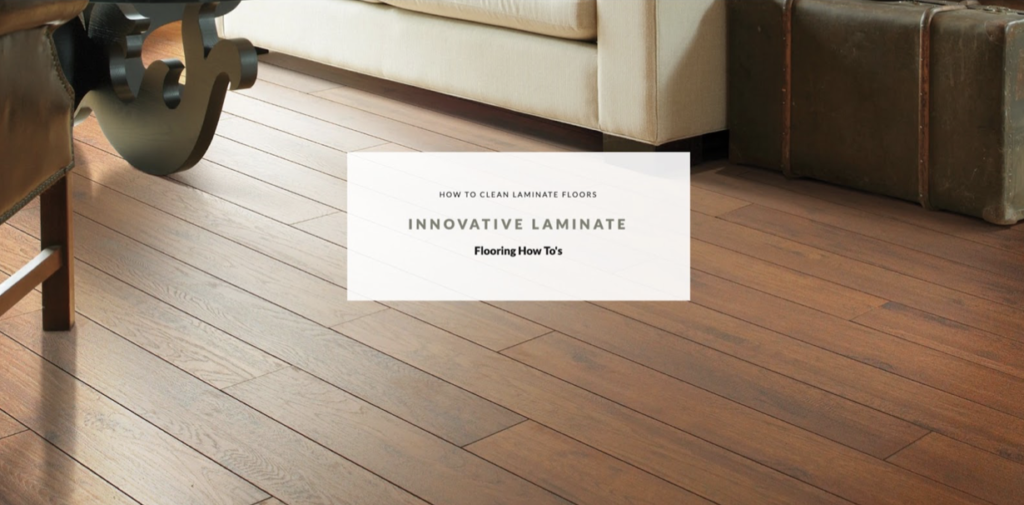
Laminate Flooring is naturally durable, making cleaning a breeze. Here, we’re going to give you the crash course on how to care for your Laminate flooring and keep it looking great for years to come. The main thing you should remember is that moisture and wood don’t mix–period. Since our Laminate is made with wood, avoiding its exposure to moisture is a must.
Routine Cleaning Laminate Floors:
- Do not use steam cleaners or wet mops, which may cause irreparable damage to your floor.
- Use a damp cloth to blot up spills as soon as they happen. Never allow liquids to stand on your floor.
- For tough spots, such as oil, paint, markers, lipstick, ink or tar, use acetone/nail polish remover on a clean white cloth. Then wipe the area with a damp cloth to remove any remaining residue.
- Sweep, dust, or vacuum the floor regularly with the hard floor attachment (not the beater bar) to prevent the accumulation of dirt and grit that can scratch or dull the floor finish.
- Periodically clean the floor with cleaning products made specifically for laminate floor care.
- Do not wash or wet mop the floor with soap, water, oil-soap detergent or any other liquid cleaning product. This could cause swelling, warping, delamination, and joint-line separation, and void the warranty.
- Avoid using steel wool, abrasive cleaners, or strong ammoniated or chlorinated type cleaners.
- Do not use any type of buffing or polishing machine on your laminate floors.
- For spots such as candle wax or chewing gum, harden the spot with ice and then gently scrape with a plastic scraper, such as a credit card. Be careful not to scratch the flooring surface. Wipe clean with a damp cloth.
- A more frequent dust-mopping or vacuuming schedule may be required in very sandy areas such as a beachside home.
How To Keep Your Laminate Flooring Looking Brand New:
- Entry mats will help collect the dirt, sand, grit, and other substances such as oil, asphalt, or driveway sealer that might otherwise be tracked onto your floor.
- To prevent slippage of area rugs, use an approved vinyl rug underlayment.
- Use floor protectors and wide-load bearing leg bases/rollers to minimize the chance of indentations and scratches from heavy objects. As a rule, the heavier the object, the wider the floor protector.
- Maintain a normal indoor relative humidity level between 35% and 65% throughout the year to minimize the natural expansion and contraction of the wood.
- Heating season (Dry): A humidifier is recommended to prevent excess shrinkage due to low humidity levels. Woodstove and electric heat tend to create very dry conditions.
- Non-Heating Season (Wet): An air conditioner, dehumidifier, or periodically turning on your heating will help to maintain humidity during the summer months.
- Avoid excessive exposure to water during periods of inclement weather.
- Keep your pets’ nails trimmed to prevent them from scratching your floor.
- Never try to slide heavy objects across the floor.
- Use a protective mat for furniture or chairs with castors.
How To Clean A Hard Laminate Surface:
- Do not wash or wet mop the floor with soap, water, oil-soap detergent, or any other liquid cleaning material. This could cause swelling, warping, delamination, joint-line separation, or other damage that may not be covered by your warranty.
- Do not use steel wool, abrasive cleaners, or strong ammoniated or chlorinated type cleaners.
- Do not use any type of buffing or polishing machine.
- For spots such as candle wax or chewing gum, apply a gel solvent or isopropyl alcohol and let dwell for a few minutes. Gently scrape with a plastic scraper, such as a credit card. Be careful not to scratch the flooring surface. Always clean with neutral cleaner or rinse with water to remove residue.
- A more frequent dust-mopping or vacuuming schedule may be required in very sandy areas such as a beach home.
Environmental Protection For Laminate Flooring:
- Entry mats will help collect the dirt, sand, grit, and other substances such as oil, asphalt, or driveway sealer that might otherwise be tracked onto your floor.
- To prevent slippage of area rugs, use an approved vinyl rug underlayment.
- Use floor protectors and wide-load bearing leg bases/rollers to minimize the chance of indentations and scratches from heavy objects. As a rule, the heavier the object, the wider the floor protector.
- Maintain a normal indoor relative humidity level between 35% and 65% throughout the year to minimize the natural expansion and contraction of the wood.
- Heating season (Dry): A humidifier is recommended to prevent excess shrinkage due to low humidity levels. Woodstove and electric heat tend to create very dry conditions.
- Non-Heating Season (Wet): An air conditioner, dehumidifier, or periodically turning on your heating will help to maintain humidity levels during the summer months.
- Avoid excessive exposure to water during periods of inclement weather.
- Keep your pet’s nails trimmed to prevent them from scratching your floor.
- Never try to slide heavy objects across the floor.
- A protective mat should be used for furniture or chairs with castors.
Glue-less Laminate Board Replacement Repairs:
- Glueless laminate may be assembled and disassembled several times.
- Carefully disassembled glueless joints will retain their original locking integrity during re-assembly. New replacement plank(s) should be acclimated in the
- Replacement area for at least 72 hours, to allow them to equalize to the conditions of the flooring in the room where the replacement(s) will take place.
- Remove baseboard, wall base, or quarter-round as needed to replace the damaged board(s). Take the flooring apart, 1 row at a time, by lifting the rows to detach them, then separating the individual boards.
- Be sure to stack the individual planks in the proper order for re-installation. This usually eliminates the need to cut planks for start or end of the row lengths.
- Replace the damaged board with a piece from the edge of the original installation.
- Insert the properly acclimated new plank(s) along the outer edge of the original flooring installation during re-assembly. This minimizes the chance that a newer plank might stand out from the wear condition of the original installation.
- Re-install the baseboard, wall base, or quarter round, and the replacement repair is complete.
Minor Laminent Repair Instructions:
In the event that accidental damage occurs to one of the planks, minor scratches or dents can be repaired using a Flooring Touchup or Color-fill Kit. This special touchup kit is a filler material, color-coordinated to the color of your floor that, when used properly, makes repaired areas often invisible. The repaired area will hold up to foot traffic and wear just like the rest of your laminate flooring.


